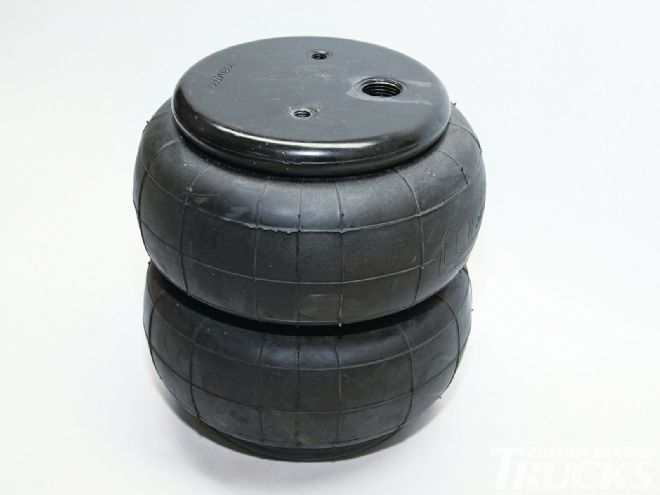
When we started project Hot Rod Hauler, our intent was simple enough, we wanted to make our workhorse ’73 Ford 350 a little more comfortable, a lot better looking, and no less of a utilitarian pickup than it was when we started.
In our last installment we slipped a pair of dropped I-beams from airbagIt.com under the front and added a pair of airbags to go along with those in the rear. This time around we’re adding the air management system
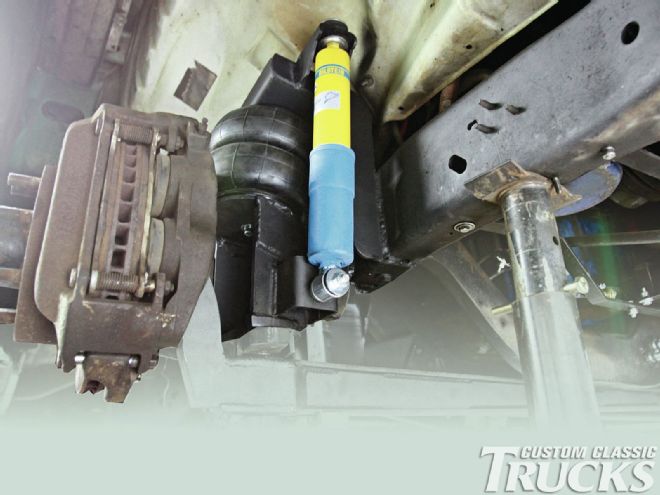 It’s always best to use the largest airbag that will fit. We used DeNominator convoluted bags from airbagit.com that are 6.25 inches in diameter.
It’s always best to use the largest airbag that will fit. We used DeNominator convoluted bags from airbagit.com that are 6.25 inches in diameter.
Air suspension has been around for a long time. The Cowley Motor Works developed one of the first systems in the early 1900s in England, however it was plagued by leaks and was considered a failure. In the ’30s, Firestone developed a system for the experimental Stout-Scarab, but the expense made it impractical for production. While air suspension still had not caught on, refinements continued.
General Motors began developing airbags for commercial use in 1952 and by 1958 they appeared on some GM cars. Cadillac offered a system that was designed to be self-leveling and compensate for passengers or varying loads in the trunk but in operation these early air systems were often slow to react, if they did at all. And while the ride quality was considered to be good, the controls were so trouble prone that many were removed and the airbags were replaced with conventional springs.
While air suspension got off to a slow start in passenger cars, it grew rapidly in popularity in the truck market. Airbags can be found in the seats and suspending the cabs of trucks to smooth out the ride for over-the-road haulers. Of course, the obvious advantage to airbags is that the suspension can be adjusted to fit varying load requirements—it can support a tremendous amount of weight when necessary without beating up the truck, or the driver, when empty. That’s exactly why we want it in the Hot Rod Hauler.
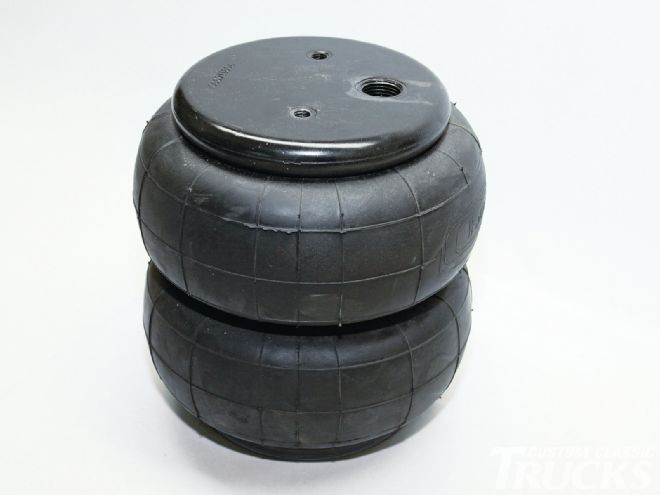 The #2500 DeNominator bags have a closed height of 2.8 inches, maximum extension is 10.25 inches and we established ride height at 6.5 inches; capacity is 2,096 pounds per bag and they are rated for 600 psi. Note that these bags have 1/2-inch inlets.
The #2500 DeNominator bags have a closed height of 2.8 inches, maximum extension is 10.25 inches and we established ride height at 6.5 inches; capacity is 2,096 pounds per bag and they are rated for 600 psi. Note that these bags have 1/2-inch inlets.
Since 1992, Joe Morrow has been providing air suspension for just about anything with wheels. His airbagit.com web site offers everything from individual parts up to and including complete plug-and-play kits, that’s why we turned to them to get our F-350 on air.
Along with all the pieces and parts Joe can provide, he also has a wealth of information gathered from years of experience putting systems together. Here, with the help of airbagit.com, is a look at the major components of an air suspension system.
The Basics Of Bags
According to Joe, the diameter of an air spring is directly related to the pressure required to attain ride height. In other words, a small diameter bag will take more pressure to lift the weight of your truck than a larger diameter bag. A truck with a heavy engine and a small bag could require 160 psi to get to ride height (which would result in a horrible ride), while with a lighter combination and a bigger bag 45 psi would be required (which would provide a much better ride). What it boils down to is this—the less pressure required to lift the vehicle, the smoother the ride. For that reason Joe recommends using the largest bag that will fit into the available space. We used the double-convoluted DeNominator air bags with a capacity of 2,096 pounds per bag on the Hot Rod Hauler.
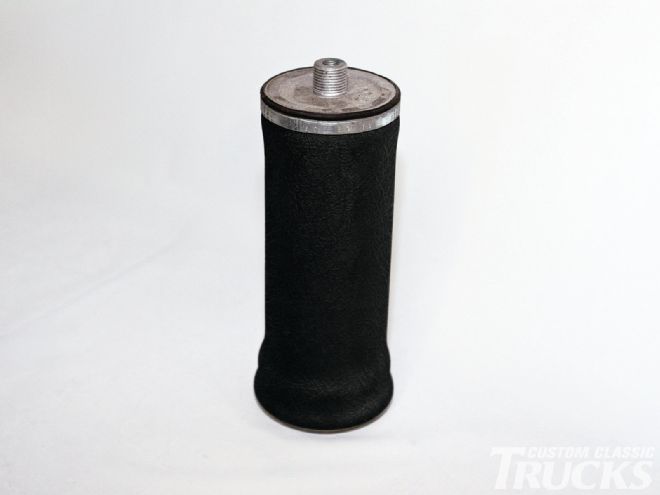 By comparison, these #800 bags have a diameter of 3.5 inches, a minimum height of 6 inches, and a maximum length of 10 inches. Capacity is 1,500 pounds per axle and they are rated for 150 psi.
By comparison, these #800 bags have a diameter of 3.5 inches, a minimum height of 6 inches, and a maximum length of 10 inches. Capacity is 1,500 pounds per axle and they are rated for 150 psi.
Ride Height And The Sweet Spot
The sweet spot, as defined by Joe, is the perfect ride quality. However, there are often different expectations from air suspension systems. Some want to be able to lay their truck’s frame on the ground; others want to jack them up, so one size seldom fits all. Airbagit.com designs their kits to lower ride height by 3 inches; to go lower or higher will require custom brackets, which they offer.
In our experience, the best ride, or sweet spot, has been achieved by making sure the airbags were at the specified installed height with the truck at ride height. All bags have a minimum compressed and maximum extended length, installed height is somewhere in the middle.
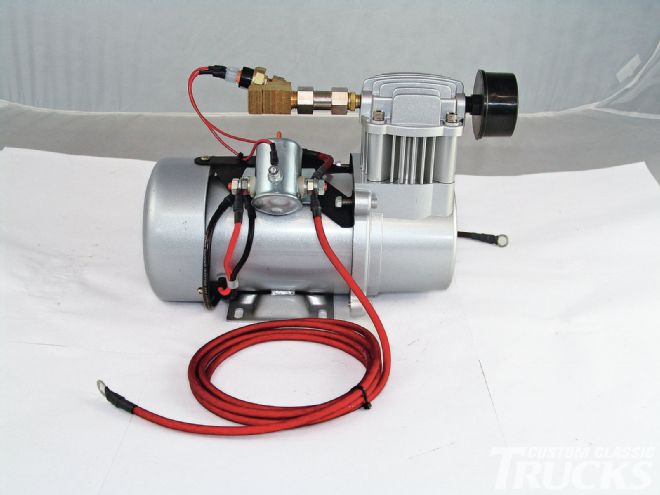 Compressors come in a variety of capacities, This is a DC 7600 that delivers 4 cfm and has a 3/4-hp motor.
Compressors come in a variety of capacities, This is a DC 7600 that delivers 4 cfm and has a 3/4-hp motor.
Compressors
Compressors are the heart of the system, but they can’t run continuously. A compressor is rated by the pressure it will produce, but even more important is the duty cycle, which is how long it can run in a given period of time. Most airbagit.com compressors have a 50-percent duty cycle, which means that the compressor can run for 10 minutes, then must be off for 10-minutes. During the “on” time the motor is pressurizing the tank, during the “off” time, the suspension uses the air stored under pressure in the tank. If the suspension is raised and lowered too frequently the compressor’s motor will run longer than it should, which leads to overheating, which will shorten its life considerably.
Choosing A Storage Tank
In most cases a storage tank will be part of an air suspension system and Joe cautions that this is one case where bigger is not necessarily better. The air capacity of the tank has to be matched to the volume produced by the compressor. Joe recommends one DC5000, or DC7500 compressor for each 3-gallons of tank capacity. He adds that larger air tanks are OK, as long as the system has the capability to fill them. Joe also points out that it takes longer for one compressor to fill a big tank and the lifespan of the compressor will be drastically shortened if it is overworked.
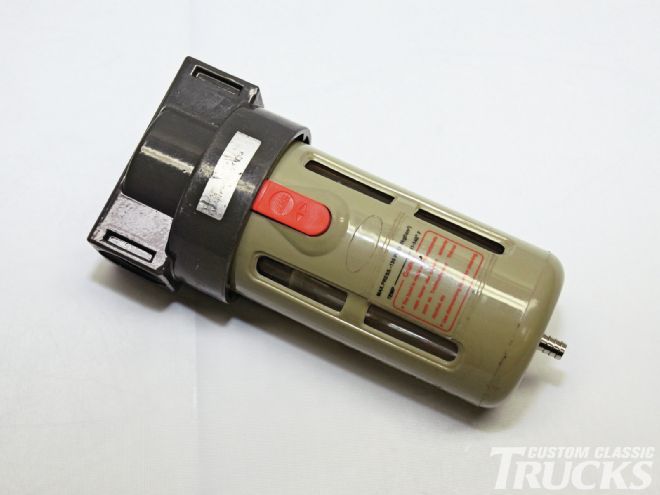 This is the water/oil separator. It discharges condensation automatically through a pressure-sensitive drain in the bottom of the housing.
This is the water/oil separator. It discharges condensation automatically through a pressure-sensitive drain in the bottom of the housing.
Its recommended that all tanks be equipped with a drain valve and the system must have a pressure switch to turn the compressor on and off. Joe cautions that when more than 135 psi is required to shut off the pressure switch the bags are too small in diameter.
Control Systems
In our experience, it’s always best to control bags individually. In some cases the bags on one axle are hooked together, however, this can cause them to transfer air when cornering. As the truck leans, air is transferred from the bag under a heavier load to the other side, which makes the truck lean even more.
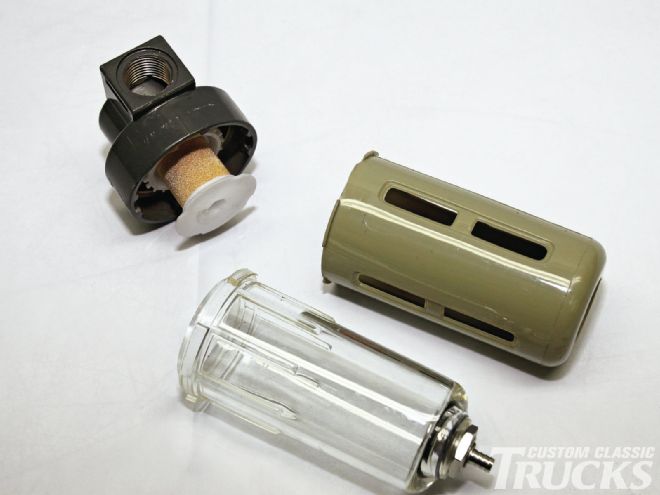 Inside the separator are directional vanes that help separate the oil and water from the air and a bronze filter element.
Inside the separator are directional vanes that help separate the oil and water from the air and a bronze filter element.
The simplest and most affordable air control system is a Schrader valve (just like those used to inflate and maintain the pressure in tires). These manual valves can be installed in a hidden location. Schrader valves are also handy to have to inflate a bag in an emergency if there is a problem with an airline.
Pneumatic Valves
These are miniature valves that connect directly to each airbag to control their inflation. For a two-bag system there will be two up buttons and two down buttons and usually one gauge with two needles. Four bag systems will have four sets of buttons and two dual-needle gauges. These controls typically use ¼-inch airlines.
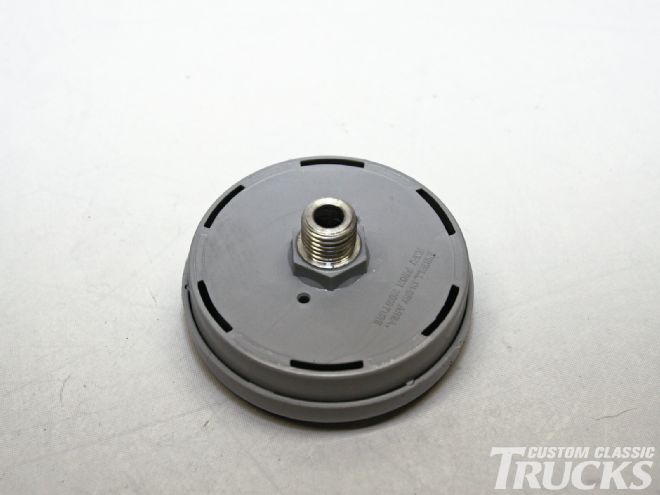 Incoming air also needs to be filtered. This filter screws into the compressor’s inlet.
Incoming air also needs to be filtered. This filter screws into the compressor’s inlet.
Electric Valves
These systems use switches to control electrically operated valves to inflate or deflate the bags and are much faster than the pneumatic style.
With electric controls, each bag will have a switch with three positions—up, down and neutral. Again, dual needle gauges are often used, however, controls with digital readouts are also available.
Water Traps/Air Dryers
The biggest enemy of air systems, particularly electric control valves, is contamination from moisture. When air is compressed, condensation forms in the system and that can cause steel air tanks to rust. That rust finds its way into the valves and prevents them from operating properly. The best protection from this is upgrading to a stainless steel tank.
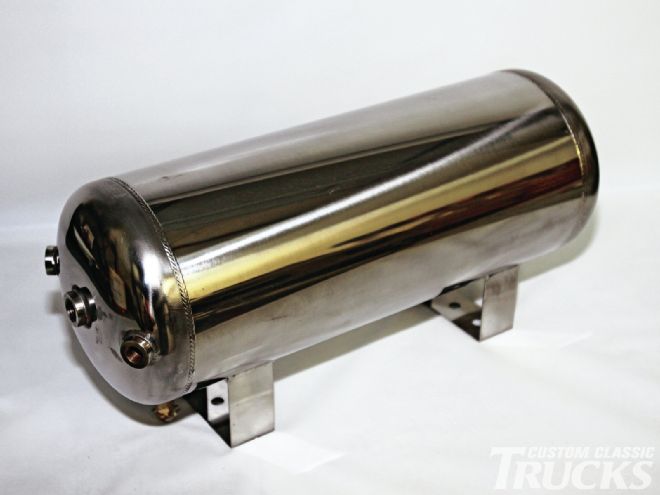 One of the best means to eliminate rust from contaminating the system is by stepping up to a stainless steel air tank.
One of the best means to eliminate rust from contaminating the system is by stepping up to a stainless steel air tank.
In addition, air systems should be equipped with a water trap. The simplest is a manual drain on the tank. The problem is you have to remember to use it regularly. A better choice is an automatic drain. When installing a water trap it should be placed on the outlet of the tank before the valves.
Another source of contamination is often the installer. The careless use of sealant and Teflon tape can result in trash in the system that will get caught in the valves. Use sealant sparingly, and start Teflon tape one or two threads from the end of the fittings.
Despite the fact that airbags are used on trucks that weigh in at 80,000 pounds, there are still those who have concerns about their strength. According to airbagit.com, their bags are designed by Chassis Tech and have a burst safety margin of up to 600 psi, five times more than will ever be needed. They claim bags will never see over 200 psi—there’s no way they’ll ever blow out unless they are damaged.
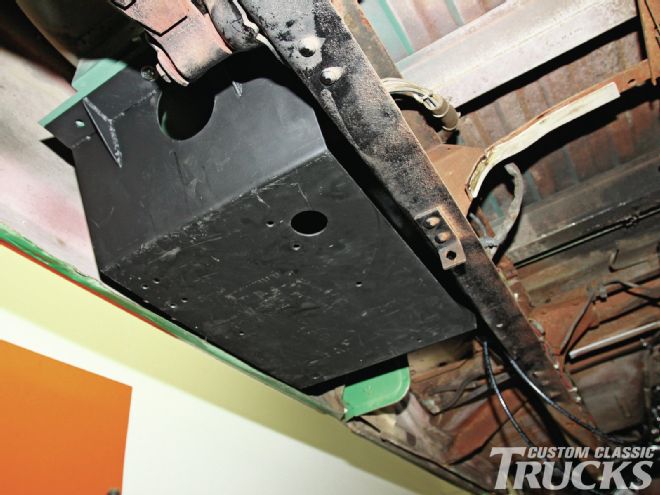 A test fit of the bracket proved everything would fit. The hole in the bottom is to access the drain valve on the tank. A splash shield (not shown) deflects water coming off the rear tire.
A test fit of the bracket proved everything would fit. The hole in the bottom is to access the drain valve on the tank. A splash shield (not shown) deflects water coming off the rear tire.
While airbags can be hurt internally by moisture accumulating over the years, a more likely cause of failure is a hole worn in the bag from rubbing against something. It goes without saying that the bag must not be allowed to touch anything in operation.
Another way bags are damaged is by over-extension. Bags have a maximum length that should never be exceeded—that can be controlled by shock absorber extension, or some sort of restraint, if necessary.
Air suspension systems are usually plumbed with DOT-approved air brake line. It has proved to be extremely reliable, but again it must not be allowed to rub on sharp edges or any components that move.
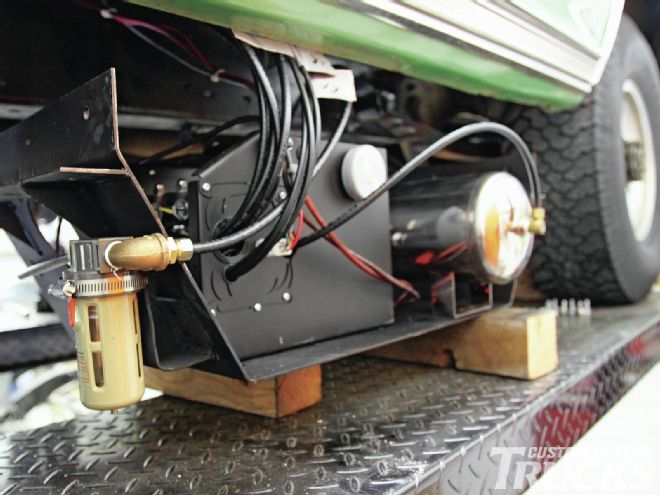 Here, the filter, compressor and tank are bolted in place on the mount. Before the assembly was lifted into place it was allowed to run while we checked for air leaks. If servicing of the components is required the entire unit is dropped out.
Here, the filter, compressor and tank are bolted in place on the mount. Before the assembly was lifted into place it was allowed to run while we checked for air leaks. If servicing of the components is required the entire unit is dropped out.
Compressors are usually reliable but if they run for extended periods due to leaks in the system (or being undersized) their life span can be shortened. In addition, filters should be used on the intake ports to keep dirt out of the intake tract.
The Hot Rod Hauler System
For our system, we used an airbagit.com plug-and-play system with a ¾-hp DC7500 compressor it included electric control valves, a four-button control panel with two twin gauges and a stainless air tank. Up front are DeNominator convoluted bags, in the rear are the same bags used as overloads on the leaf springs (we’ll be showing how we redid that arrangement to lower the rear of the truck to go along with the dropped axles we installed last month). CCT